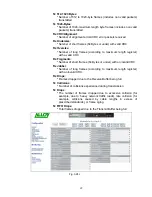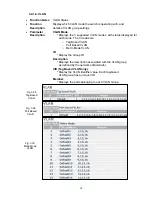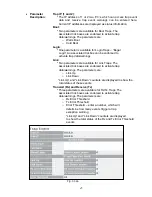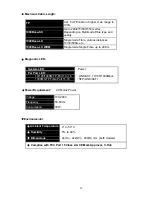
50
that the power cord is firmly seated. Alloy 16/24 gigabit Switches have a power cord
clamp fitted – use of this device will ensure that the power cord cannot be easily
displaced.
4.3 Basic Troubleshooting
As mentioned above, it is not possible to cover all aspects of troubleshooting a switch that is
apparently exhibiting operational problems in this manual. However, the following items
should be checked in the advent of certain types of difficulties with the basic operation of the
switch:
•
The Switch Fails To Power up
:
⇒
Ensure the AC power cord is connected to the mains outlet and the switch AC power
inlet correctly, and both the mains socket and the switch is turned on
otherwise
⇒
Check and ensure that the mains circuit from which the switch is drawing power is
functioning
•
One or More Ports Fail to Link
:
⇒
Ensure the switch is powered on (see above)
⇒
If you have just powered on the switch, check that it has finished it’s POST check
and has assumed an operational state
⇒
Check that the cable(s) connected to the ports that do not give link are of the correct
type. Example 1: Cat 3 UTP cable cannot be used on a Gigabit Ethernet network.
Example 2: a singlemode type fibre optic cable will not operate correctly connected
to a mini-GBIC fibre optic module whose transceiver is of multimode type, even
though the cable can be physically connected
⇒
Check that the length of the cable connected to the port is within the range
prescribed by the relevant standard (for example, Cat 5e UTP for Gigabit Ethernet –
maximum range of 100 metres)
⇒
Check that the cable you are using is functioning correctly (the simplest way to do
this is to transfer the cable to a port that currently has a valid link with it’s associated
node device, install the suspect cable, and observe if a valid link is achieved)
⇒
If all the above items have been checked, it is possible that a fault has developed on
the individual port in question. Contact your Alloy agent
⇒
If the network node device at the remote end of the link (Network Adapter Card,
Switch, Hub etc) is an older legacy device, it may not support Nway auto-negotiation,
as in the case of modern switches. In such cases, it is possible that your Alloy 16/24
Gigabit switch has not been able to synch speed and/or duplex characteristics
correctly with the legacy device. For example, the Alloy 16/24 Gigabit switch may
have set the port to full duplex mode whilst the remote device is set to half duplex.
Check the management interface of your Alloy 16/24 Gigabit switch to determine the
speed/duplex mode, and if your remote legacy device has a management
utility/interface, check the settings at that end of the link. Correct any mismatch at
the remote end.
Содержание 16-PORT GIGABIT WEB SMART SWITCH GSS-16T2SFP
Страница 2: ...ii June 24th 20005...
Страница 6: ......





































